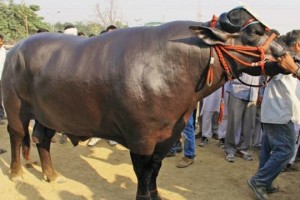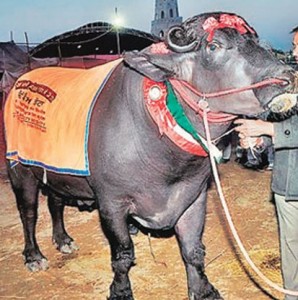While delivering a lecture to a batch of educated dairy farmers I showed them a picture of a man, who was 8 feet tall and weighed 350 kg, and asked them if they would agree to marry their daughter or sister with such a person. The farmers’ response was a firm ‘No’ and the reason expressed was: ‘abnormal personality would lead to abnormal progeny’. Then I showed them pictures of the Murrah breed buffalo bulls ‘Raju’ and ‘Yuvraj’, constantly in news for their physical feat; both weighing more than 1400 kg, with length 14 feet and height 5.8 feet. When asked if they would agree to breed their buffaloes with this bull, many quietly nodded and few said ‘yes’. The reason elaborated was that female calves born to these grand hefty bulls would be better milk producers.
It is common myth prevalent in farmers that large frame bull would mean better genetics which must be an outcome of frequent but persistent coverage in press and digital media about bulls presented in the shows who are judged based on their appearance. Such is the power of media that veterinarian friends from USA and Canada who have spent their life in animal breeding called me to express shock at the level of genetic and breeding knowledge in the country although we boast to be breeding cattle since time immemorial compared to western country farmers. Their shock was obvious as these bulls were also awarded in exhibitions organized by premier institutes like IARI and national shows organized by veterinarians where it was expected that judging will be a professional pursuit. So, I decided to take the ‘bull by the horns’ and write this article to speak loudly on the topic for larger benefit of our farmer community and policy planners. I must also mention that the two bulls being personal properties of the two farmers, their owners have full right to feed the animal as per their choice and use these bulls for breeding on their buffaloes but since as per reports in media, the two enterprising farmers have started marketing semen of these bulls based on misguided facts, charging heavily to gullible farmers it is necessary to set the records straight.
Let us consider their physical merits first. Both the bulls weigh heavy around 1400 kg as compared to typical weight of around 900 – 1000 kg. Does this trait make them genetically superior? Would there be any genetic gain in milk production if such bulls are used for breeding dairy buffaloes? The answer is a firm ‘No’ for three reasons. First, there is no known correlation between adult body weight/large frame of a buffalo bull and daughters’ milk yield potential. Second, such bulls would be considered un-desirable, since due to high heritability of adult body weight (0.65), a calf conceived would most likely be of a large size and weight. If the calf-carrying buffalo is of short frame it would cause difficult birth, damage to reproductive organs and infections. Further, it is now proved that heavy frame bulls should never be used on ‘heifers’ (young buffalo being bred for the first time) due to increased chances of complicated birth and mortality. Third, the surviving daughters born to such bulls will be of large frame which is in contrast to the global trend of small-frame cow, with high milk potential, less feed consumption hence increased profits. Also very heavy weight dairy animals have high culling rates due to increased feet and hooves problems. On the contrary bulls of heavy adult weight and frame are preferred as beef breed (for meat) but certainly not for milk production.
The other good trait reported is that mothers of these bulls have yielded around 25 kg milk per day and the belief is that the daughters born to these bulls would also be high milk producers. The owners have probably reported ‘peak yield’ (highest milk produced in a day during the lactation). Peak yield in dairy animals may reflect genetic potential but not actual lactation yield which is the correct economic parameter to consider. As per international standards accepted even by India as signatory to International Committee on Animal Records, lactation yield can only be calculated with minimum 11 milk records measured at interval of 30 days along with fat content at each recording day. This yield must be corrected for fat and lactation days for uniform comparison. For dams of these two such data is not available in public. What is the authenticity of even 25 kg milk their dams yielded? World-wide breed superiority data as milk production and physical traits are officially announced by competent government-approved organizations by giving ranks. Absence of such authorities in India therefore is major cause of self-claimed genetic superiority by farmers themselves. My main objection is that superiority of mother’s milk production does not guarantee transfer of superior genes to its successive generations. In a lactating female it is easy to measure milk production potential but since bulls do not yield milk their capacity to transfer milking genes need to be evaluated indirectly. The method followed globally is progeny testing in which first lactation yield in minimum 50 daughters (preferably first calves) sired by bull is measured and statistically analyzed. If adjusted milk yielded by daughters is higher than lactation yield of contemporary daughters fathered by other sires then the bull is ‘officially ranked’ and declared progeny tested. The other quick and direct method is ‘selection by genetic markers’ wherein gene variants are identified to predict superiority. Since the two bulls have not gone through such tests of proof, it is wrong to claim that these are genetically superior. It is not understood why state government officials have not helped these farmers in getting these bulls tested. Unfortunately, we don’t have traceability system hence it will be difficult to identify the served dams and the daughters born to these bulls for undertaking a quick verification of the facts. The owners of these bulls must have been benefitted from all the publicity in media and government awards giving fillip to their enterprising spirit. But for marketing semen legally bulls must pass a set of criteria and be approved by the Central Monitoring Unit of the Department of Animal husbandry and Dairy of Government of India (as well as state government in case of private semen producers). Bulls can transmit many genetic disorders and infectious diseases hence these must be declared free before their semen is marketed. Semen of these bulls must also be tested periodically for sperm counts and other attributes to ascertain fertility potential. For these bulls no such data is available in public domain. Marketing of semen from officially non-tested and unproven bulls would cause tremendous irreparable harm to a large buffalo population in the area (15,000 semen doses per bull per year is being marketed). It is therefore high time that the state departments intervene and help these farmers in getting bulls genetically proven; till that time, these bulls should not be permitted to participate in breeding program.
The media reports also highlighted faulty feeding practices (feeding of milk, curd, apples) in these bulls, which may influence other farmers to indulge in similar practices with a belief to improve health and milk production in their animals. In the interest of the farmer community it is necessary to dispel such feeding myths. Both the farmers are feeding 15-20 kg milk, 5 kg yoghurt and around 5 kg apples every day with cattle feed. Milk consumption is of course fine for young animals. However, no text books on animal nutrition recommends feeding of milk or yoghourt to an adult cow or buffalo as these are ruminants wherein feed is digested through ‘anaerobic fermentation’ brought about by billions of ruminal microbes. Lactose is a soluble carbohydrate in milk which is easily fermented to acid which in turn can produce severe acidosis. In India eating apple daily is considered as sign of being elite and for this reason the owner must be feeding Yuraj 5 kg apple every day. If nutritive value of apple costing Rs. 100 per kg has been reported to be inferior to corn silage costing around Rs. 2 per kg. High soluble carbohydrate content in apple has been reported to cause chronic rumen acidosis and ruminits leading to several complications. I don’t wish to blame these and such other farmers as they must have adopted these practices to impress and show elite feeding and management approach. In fact jury members who have judged these bulls as superior without supporting scientific data should be blamed for enabling the owners of these bulls to exploit publicity and charge 60-70 fold higher price for semen. It is also unfortunate that even though Kapurthala, Raju’s home, is only 80 km from an excellent veterinary university in Ludhiana and Kurukshetra, Yuvraj’s abode is only 37 km away from National Dairy Research Institute in Karnal, their extension services and technologies have not reached these farmers. Does it not show that our farmers are in fact craving for genetically superior bulls and are ready to pay any price? It is the duty of state departments, veterinary universities and national institute to become pro-active and help enterprising farmers like owners of these bulls to set up science and technology-based enterprise.
To review the media publicity mentioned in this article readers can visit news item of following leading brands:
Contributed by:
 Prof ( Dr ) Abdul Samad
Prof ( Dr ) Abdul Samad
MVSc, PhD ( Canada )
Dr Samad is a renowned herd health and veterinary medicine expert. Click Here for his short profile.
You can write to Dr.Samad at drasamad11@gmail.com






